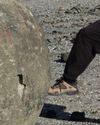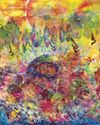Siobhan Lyons perceives the flow of history in terms of organic growth and decay.

Our contemporary obsession with modern ruins, ambiguously dubbed ‘ruin porn’, has a tendency to trivialise the importance of such sites, which appear out of phase with our normal experience of the present. In her book Dispatches from Dystopia: Histories of Places Not Yet Forgotten (2015), historian Kate Brown talks instead of ‘rustalgia’ (cf nostalgia). For Brown, while some people speak of their ‘lustful’ attraction to such sites, “others will speak in mournful tones of what is lost, what I call rustalgia” (p.149). Rustalgia both transforms and transports us, underpinning the more philosophical elements of these places, while ‘ruin porn’ makes them into nothing more than objects to gape at. She thinks her term and what it draws attention to will help us understand how “sketchy is the longstanding faith in the necessity of perpetual economic growth.”
Focusing On The Future
Bu hikaye Philosophy Now dergisinin December 2017 / January 2018 sayısından alınmıştır.
Start your 7-day Magzter GOLD free trial to access thousands of curated premium stories, and 9,000+ magazines and newspapers.
Already a subscriber ? Giriş Yap
Bu hikaye Philosophy Now dergisinin December 2017 / January 2018 sayısından alınmıştır.
Start your 7-day Magzter GOLD free trial to access thousands of curated premium stories, and 9,000+ magazines and newspapers.
Already a subscriber? Giriş Yap

Metaphors & Creativity
Ignacio Gonzalez-Martinez has a flash of inspiration about the role metaphors play in creative thought.

Medieval Islam & the Nature of God
Musa Mumtaz meditates on two maverick medieval Muslim metaphysicians.

Robert Stern
talks with AmirAli Maleki about philosophy in general, and Kant and Hegel in particular.

Volney (1757-1820)
John P. Irish travels the path of a revolutionary mind.

IT'S A WONDERFUL LIFE
Becky Lee Meadows considers questions of guilt, innocence, and despair in this classic Christmas movie.

"I refute it thus"
Raymond Tallis kicks immaterialism into touch.

Cave Girl Principles
Larry Chan takes us back to the dawn of thought.

A God of Limited Power
Philip Goff grasps hold of the problem of evil and comes up with a novel solution.

A Critique of Pure Atheism
Andrew Likoudis questions the basis of some popular atheist arguments.

Exploring Atheism
Amrit Pathak gives us a run-down of the foundations of modern atheism.